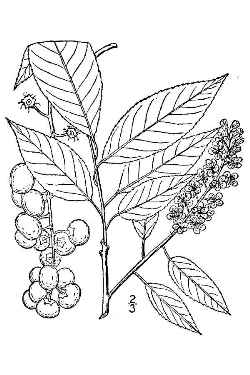
Padus virginiana, Britton, N.L., and A. Brown. 1913. Illustrated flora of the northern states and Canada. Vol. 2: 329.
Sunset®: 1-3,10
USDA: 2-7
Sun Exposure: Full sun to part shade
Origin: Eastern North America, Saskatchewan to Newfoundland south to Kansas, Missouri, Tennessee and North Carolina.
Growth Habits: Small, deciduous tree, 20 to 30 feet (6-9 m) or more, 15 to 20 feet spread (4.5-6 m) ; oblong to nearly oval leaves, with finely toothed margin, 2 to 4 inches long
Flowers: White flowers
Watering Needs: Moderate water, needs well drained soil
Propagation: seed (stratified), suckers
The name Chokecherry refers to the bitter and astringent taste of the berries.
'Schubert' is a variety with purple foliage. Its foliage open green and gradually turns purple.
Blooming Habits:
Almond scented white flowers, in a loose terminal raceme, from May to June, on the leafy twigs of the season. Dark red to dark purple drupe, 0.16 to 0.32 inch in diameter (4-8 mm), maturing in summer, and staying on the tree most of the winter. The plants producing red berries are preferable for decorative purposes. The fruits are very astringent, but can be used in jellies and jams.
Culture:
The Chokecherry suckers heavily, they should be removed to prevent being invaded.
Desert-Tropicals is dedicated to provide gardening advice, gardening ideas, and information about flower of all kind for landscape and collections.We try to check carefully the identification of the plants on the illustrations as well as the other information from the page, but occasionally errors do occur. if you notice anything that needs to be changed please contact us.Thanks.
© 1998-2020 Philippe Faucon, All Rights Reserved.